Text and Photos: Anvi Mehta
“We are now in the mountains and they are in us, kindling enthusiasm, making every nerve quiver, filling every pore and cell of us”
– John Muir
MMountains are always an attractive tourist destination. Apart from Himachal Pradesh and Kashmir, which are both very famous tourist destinations, Uttarakhand is a developing mountain state that has many hidden gems just being discovered. While we have the Valley of Flowers, Auli and Chamoli in the Garhwal belt; tourism in Kumaon is still not as developed, except for Nainital, Bhimtal and Jim Corbett. (These are places closest to the railway station and airport).
Over the past few years, the tourism industry is picking up, mainly due to online promotions. Now, places like Kausani, Ranikhet and Munsiyari are seeing an increasing number of tourists. These places are developing off beat packages for tourists that include a stay in a village, a home-stay, and visits to places of local importance. This has ensured an experience which attracts tourists to these places, despite long distances from the mainland.
A gem called Munsiyari
Munsiyari, a small conglomerate of revenue villages nestled in the laps of the Himalayas, is one of the hidden gems of Kumaon. Surrounded by Tibet and Nepal on two sides, Munsiyari was of utmost importance for the traders in the historic period. It lies in between the salt route from Jowhar valley, Tibet, which extends to the Milam Glacier through Gori Ganga. It was after the 1965 war with China that all trade with Tibet ceased, and the area was restricted. But now it is being promoted as a little paradise of Uttarakhand, by the state government.
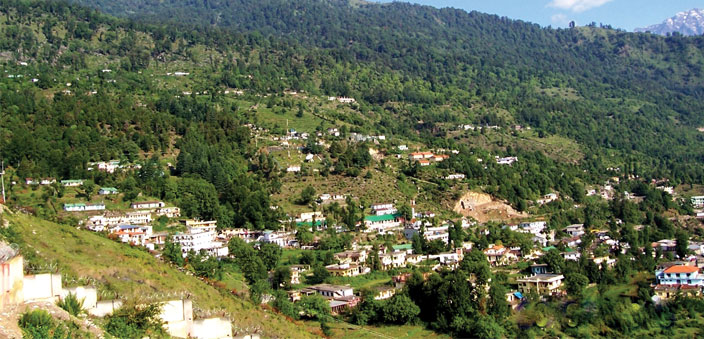
Munsiyari, at an elevation of 2290 metres, is an upcoming tourist destination owing to the spectacular view of the Panchachuli peak from the hill-station and the relatively untouched beauty. The climate in Munsiyari remains pleasant throughout the year. While there is snowfall during the winter season, summers are relatively warmer, and there are heavy showers during monsoon. However, due to recent changes in climate, Munsiyari is also getting affected by erratic snowfall, reduced rain showers, and increasing heat during summers.
While it was always popular with mountaineers and glacier enthusiasts as it served as a base camp for glaciers like Milam, Ralam and Nimak, it is now making a mark as a prominent place for family and group tourism.
Munsiyari’s people
The conglomerate of villages has 15 to 20 clusters within a few kilometres of the market area. These villages consist of Rajputs and Brahmins who are considered to have come from the lower regions and settled here. The local population is the Bhotias, the clan from Tibet and Nepal, who migrated after the modern day borders were set up. The Bhotias follow Goddess Nanda Devi and are the major traders of the area.
The occupation of the people is agriculture and cattle. Munsiyari is known for its organically grown potatoes, and after Spiti Valley, it is one of the most popular places for potatoes. Though the locals say that production of potatoes has reduced in the last few years, owing to changing climatic conditions, water scarcity and attack on crops by wild animals, there are a few potato farms that one can visit.
There are many shepherds in Munsiyari who take their sheep and go to the higher elevations during summer, and return before the onset of winter. These shepherds on their return get herbs and medicinal plants which are only found in the higher regions of the Himalayas. These herbs and medicinal plants were earlier brought for local use only; it is after the sudden surge in tourism that they are being sold to outside public. Laljadi (a stem used as an anti-inflammatory), and kidajadi (a fungi that is used as an aphrodisiac and has other healing properties), are the two main items which are brought down by the shepherd community.
Munsiyari is also known for Angoori rabbit farms; these rabbits are reared for their wool. The hand-knit woollen apparels are usually made of the Angoori wool, which is also the softest, and keeps the body warm.
To experience the local culture and food, one must choose a homestay over a resort. The local food has a Nepali-Tibetan touch to it because of the close proximity to the border regions. But, one can savour the pahadi (the mountain people’s) food which is bhatt ki chudkani, namkeen chai, aloo ke gutke, bhang ki chutney and so on.
Reaching Munsiyari
To reach Munisiyari, one has to either take the route from Thal, or else choose the one from Dhanachuli. The route from Thal passes the Kalamuni peak, the highest in the tehsil. It is a beautiful route and has mainly broken pathways with water streams flowing by. Often, when the skies are clear, Munsiyari greets tourists with a breathtaking view of the snow-clad Himalayas.
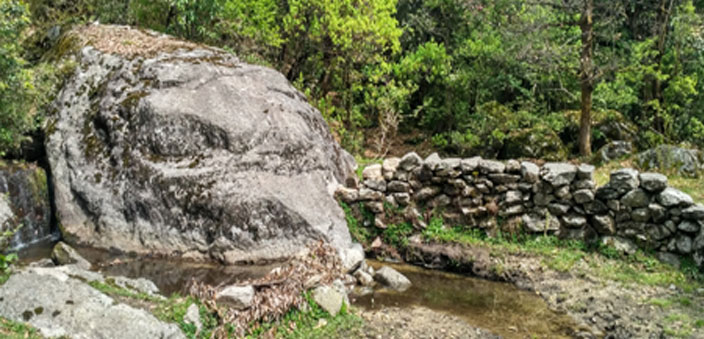
When we decided to go to Munsiyari, it was a day long travel from Lohaghat, Champawat. We had to change the jeep thrice before we could reach the hill-station. From Champawat we went to Pittoragarh (the district headquarters); Pittoragarh to Thal, and finally Thal to Munsiyari. While transportation is available from all three locations regularly, the probability decreases post afternoon.
Once in Munsiyari, you need at least a week to cover the basic treks and tourist places in and around the market area.
Nearest Railway Station: Kathgodam (278.6 km)
Nearest Airport: Pant Nagar (312.7 km)
There is less availability of state transport buses from Kathgodam to Munsiyari. Either you have to take the shared taxi which usually starts early in the morning, or you have to book a private car.
Though every inch of the place has its own beauty, right from the landscapes to the people, everything is very interesting; below are listed a few places that should definitely be on your to-do list:
The Mesar Kund
The pahadis are known for their stories, they are excellent story tellers. Every place has a story to it, be it a lake or a temple. The Mesar Kund is yet another beautiful place with an intriguing history to it.
As per locals, there was once a yaksha (nature spirit) who lived in the lake. Many years ago, the villagers living around the lake destroyed it. This did not go well with the yaksha and he cursed the villagers with a long drought period. For several years, there were no rains and the area suffered a severe dry spell. This is when the villagers performed a ritual and apologised to the yaksha. It is only after the yaksha was appeased that the drought ended. Since then, a holy ritual takes place at the kund each year.
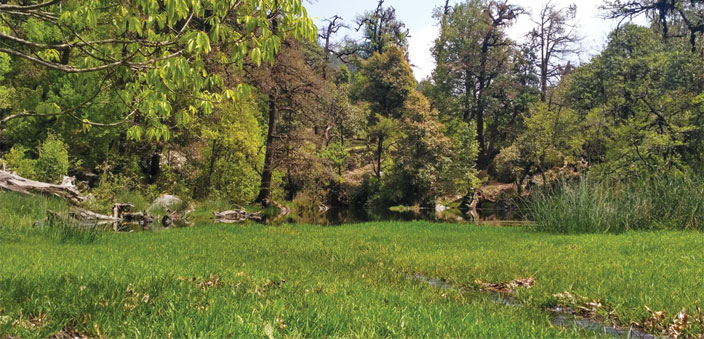
There is also an alternate tale which only a few locals talk about, in which a hermit named Mesar lived near the lake. It is said that one day he spotted two young women who had accidentally reached the lake while collecting fodder. He instantly fell in love with one of the maidens; he lured her to live with him. The other girl, frightened that her friend has been kidnapped, rushed to her village and brought back a few villagers. Though the villagers asked the hermit to return their daughter, the girl did not want to go back because she was happy with him. The villagers started to destroy the lake, when the hermit got angry and cursed them that their families will always see a death at every birth. Since then, it is said that the families of the unknown village come to the kund every year and perform rituals to please the hermit and prevent any misfortune to their families. This story is perhaps just a myth. But the hermit Mesar, is worshipped as a form of God.
The Mesar Kund is a small lake (kund) situated 3-4 km from the market area (at Sarmoli and Shankh Dhura). There are two trek routes to the kund, one from the roadside, and the other through the village of Sarmoli. We had taken the latter, and it was a moderate 500 metre trek through rocks and streams. It was a 20-30 minute walk from the village, and is quite scenic. The view of the Himalayan peaks from the elevation is truly surreal, and one reason why one must take this route instead of the marked trail.
As per locals, the Mesar Kund was a huge water body which got degraded over the past few years. When we reached, we saw two parts of the lake. One is known as the old Mesar Kund which had drastically reduced in size due to silting and eutrophication. The other one is the new kund revived by the locals in the last ten years. This part also has a shelter for tourists to sit and enjoy the location. But, due to the constant deforestation and soil erosion in the higher areas, the water in the lake is reducing. If no action is taken soon, the beauty of the place will only remain as a picture in our travel albums.
The local Van Panchayats of the two villages make sure that the area is cleaned regularly. There are cleanliness drives in which tourists also participate. It is because of the constant efforts of the community that the kund could be revived. In the olden days, it was supposed to have been covering the whole area but now it is diminishing at a rapid rate.
The Nanda Devi Temple
Nanda Devi is one of the most worshipped and holy goddesses of the state; a temple dedicated to the goddess is located at Munsiyari. The temple faces east towards the Panchachuli peak, and is situated far from the market area.
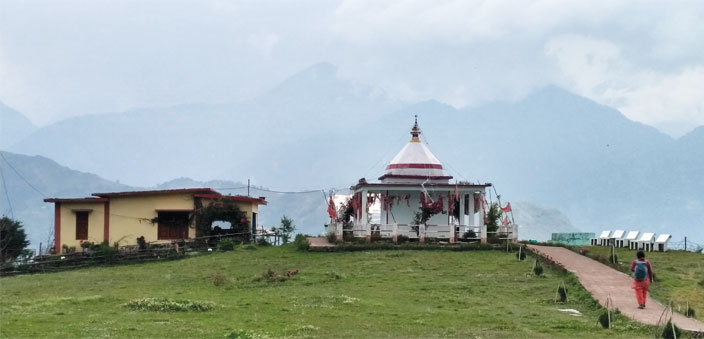
There are two routes to reach the temple, one is via the road and then a short climb to the top. The other is a forest route which starts near the post office and ends at the temple gateway. This is an interesting walk as the forest is dense, and sometimes you can meet shepherds camping in tents. They have many stories and experiences to share.
The temple site is looked after by a caretaker, and is one of the cleanest temples around. The place offers peace and serenity like no other location. The temple building is white coloured with paintings of Lord Ganesha. The idol of the deity is inside the sanctum sanctorum, and it is said that Nanda Devi is in her divinest forms here. The highest footfall is during the festivals of Navratri and Diwali, where even pilgrims from the local villages come to worship the goddess.
Throughout the temple premises, there are small enclosed structures where one can rest and enjoy the view of the Panchachuli range. There is also an elevated structure where one has to climb approximately 50 m high. The whole Panchachuli range is clearly visible from this spot, especially during early summers and after snowfall.
The Birthi Falls
About 35 km from Munsiyari, at the Thal-Munsiyari route, lies the Birthi Falls. It is a 400 feet above sea level falls which can be clearly seen from the road as well. Along with the road access, these falls can be approached via a day long trek route from Munsiyari, which is 17 km away, and can be covered in an hour. The falls are accessible during the months of October-June, when the water quantity is relatively less, and one can actually take a dip in the water. During monsoon, it is said that the falls cover most of the area, and it is dangerous to enter the waters because of its ferocious flow. The falls also offer a good view of the Himalayas, and can be developed as a major tourist attraction.
When we visited the falls, we could climb the rocks and go till the waters. The falls are spell binding, and a must-visit to anyone who loves waterfalls and water bodies. Also, once back from the waterfalls, a cup of tea and a hot plate of ‘maggi’ is a must at the entrance stall. The owner is a cheerful person, who loves talking about Munsiyari and the places around.
The Thamri Kund
Just like the Mesar Kund, Munsiyari has one other perennial water body, which is much more protected and away from the tourist radar. The Thamri Kund is located at Betuli Dhar Ridge, which is one of the most ravishing water bodies in Munsiyari. The kund is located in the deep alpine forests and it takes six to seven hours for one to go and come back from the lake. It is located in a relatively dense forest, and one can sometimes spot animals like deers and bears at the lake side. If you want to see this lake, you must start your trek early in the morning to make it back before it‘s dark. A dedicated route is marked by the forest department; hence, no guides are needed. But, if you want to know more about the local stories and tales from the past, hiring a guide would do no harm.
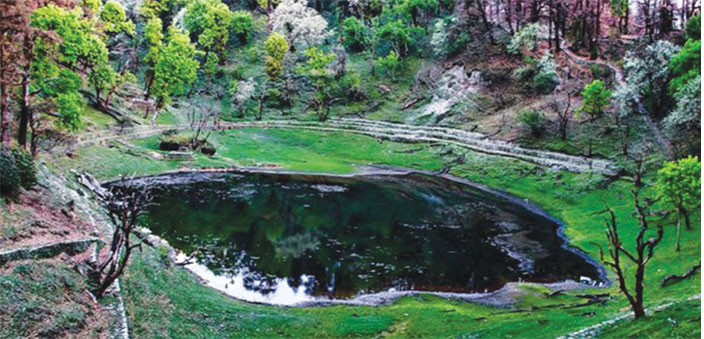
The Khaliya Top
A six kilometer trek from Balanti Farms of Munsiyari, the Khaliya Top is known for its beautiful alpine meadows. It offers hikers a view of the snow-clad mountains during early summers, where one can take pleasure in watching the panoramic view of the Panchachuli, Rajrambha, Nanda Kot and Hardeol peaks.
The trek is through forests and one must hire a guide to complete it on time and return before the night falls. There is no place to stay at the top except if you are carrying equipment to camp through the night. If you do so, staying at Khaliya overnight will be the best experience for you. But, camping is possible only during winters and summers, as monsoon witnesses heavy showers in the area.
The trek through the forest is moderately difficult, and it gets tougher as one crosses 3,000 metres. There are chances of getting altitude sickness; one must be very careful while doing this trek if you are not used to change in temperatures and higher altitudes.
The forest route is beautiful as there are many varieties of trees and birds to spot. If lucky, one can also spot deer, forest cats and baral (mountain goat), kakar and monal in the forest on their route to Khaliya. The route is filled with the smell of pines, oaks and cypress which is completely mesmerising. If you choose to do this trek during spring, you will see the blooming of white, pink and red coloured rhododendrons (the state flower of Uttarakhand). This is an ideal trek for beginners in the Himalayan landscape. Though due to rainfall, we could not complete our trek, we intend to do it on our next visit to the hill station.
The village of Sarmoli and its inspiring story
About three kilometre from the market area lies the village of Sarmoli, which is known for its community activities and homestays. The women of the village have come together as a group and started various activities like collection, packaging and sale of local food items, herbs and medicinal plants; artists sell woollen products, community events like bird watching and marathons are organised. Every year, during the summer season, events like Khaliya Top Marathon, a butterfly and bird watching festival, an art and food festival and a Mesar Forest Fair are held. We attended the festival this year, and found that it was a good community effort. One of their activities is involving locals in the tourism industry. There are homestays set up by women in their houses. We stayed in one of those homestays, a furnished room with a clean washroom. It was a very decent arrangement, and families can very well opt for it instead of the regular hotels and resorts. The food provided by the family was also cooked in their kitchen, and had a local feel to it. The best part of the homestay was the packed lunch that we could take along anywhere our itinerary took us for the day. Most of these women also work as guides to the tourist places, in case you are looking for one.
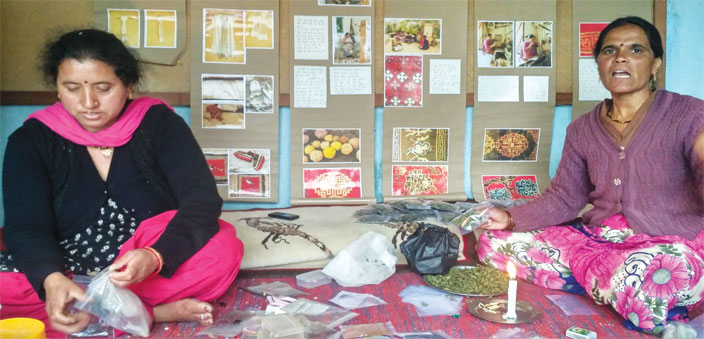
If you are interested in knowing more about the women and their community acivities, do visit their office cum work space at Sarmoli village. There is a lot to learn from these women and their work is nothing less than an inspiration. One can also shop for Yak and Angoora wool products hand knit by local artists, local grains and spices, and other locally available products from these women. It is a social enterprise encouraging women entrepreneurs.
This savvy community maintains a page on Instagram, called Voices of Munsiyari. This is by far the only Instagram page I know which is handled by the full community. A few ’handlers’ from the community upload pictures of their daily lives and the happenings in Munsiyari. The page is a must follow for any social media enthusiast.
Madkot and Darkot villages
About 22 km from the market area of Munsiyari is a small hamlet called Madkot. Apart from the splendid view and the green lush farms, the village is known for its hot water springs.The hot water spring is located at the banks of Gori Ganaga River and falls on the route towards Dharachuli. The hot water or thermal springs have high sulphur content which can heal or cure skin ailments and eruptions, and thus there is always a tourist rush to the village. The water is known to cure ailments that can inflate or cause pain to joints, muscles or tissues like arthritis. Unfortunately, we could not visit the place due to rain, but we were told that the hot springs are not well maintained. There is litter all around the springs which hampers the experience of bathing in one.
To reach the village, one can take one of the jeeps or buses that are available at regular time periods. One can also walk to the village, but the forest route is not marked, and the roads are not good. Darkot is another village which is on the Madkot-Munsiyari route, and is six kilometres from Munsiyari. It is a small village with heritage structures, and one can witness the Kumaoni couture here. It is a good destination for those who want to go on a small trek and experience the lush green beauty of the villages. The speciality of the village is hand-knit Pashmina shawls and merchandise.
The elevated Betulidhar
Another place which is a must visit especially during the spring season, is Betulidhar, which is at an elevation and offers a good view of the peaks. During spring the place is full of rhododendrons and is a beautiful sight to see. The rhododendrons are red in colour, but as one goes up to higher altitudes, the colour starts fading to a light pink and white. The flowers are used to make medicinal juices useful for ailments like diabetes. You can even ask a local to source this juice.
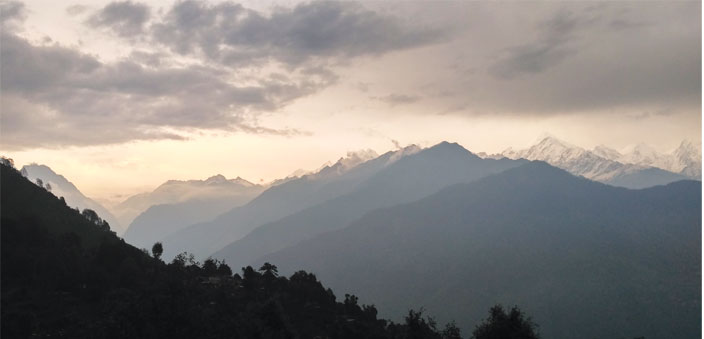
More things to do in Munsiyari
While the places listed above are part of the activities to do in Munsiyari, one can do additional activities like trekking, river rafting in Gori Ganga and bird watching. The hill-station is known for trek routes including the ones mentioned above. Any trail you go, you will end up either in a kund or a bugyal (meadow). There is a good market for shopping of Pashmina, yak wool and ordinary sheep wool products made by local villagers. The place is also known for organic and good quality potatoes which are famous all across the state. The potatoes are available once the monsoon begins.
Best season to visit
Any time of the year is good to visit Munsiyari, as every season has its own uniqueness. But to trek to the glaciers, summer is a good option. You can also go on winter treks during snow fall, especially to the Khaliya Top and Thamri Kund. The place witnesses two to three feet of snowfall each year.


 >
>